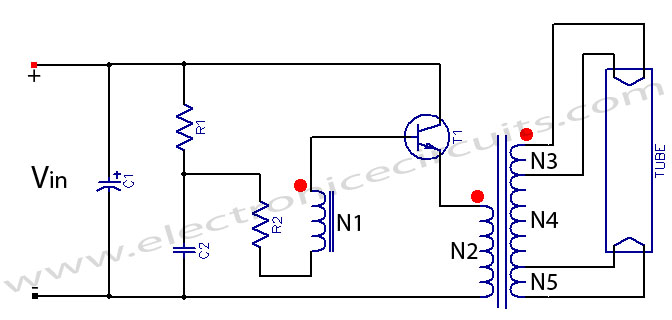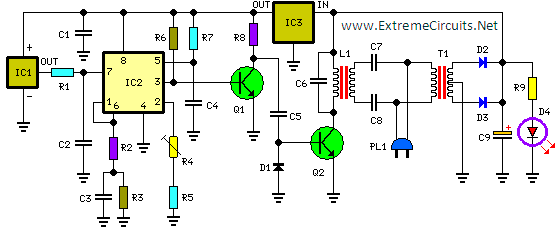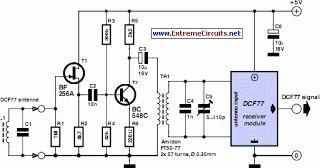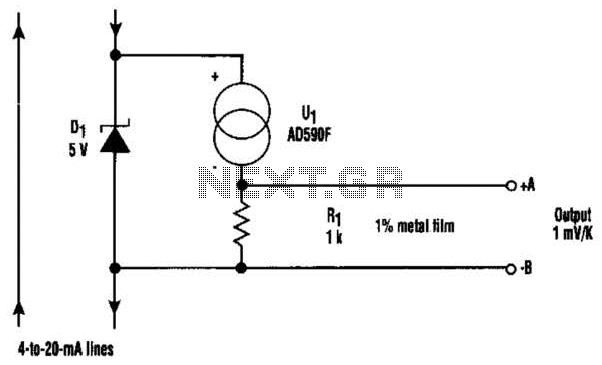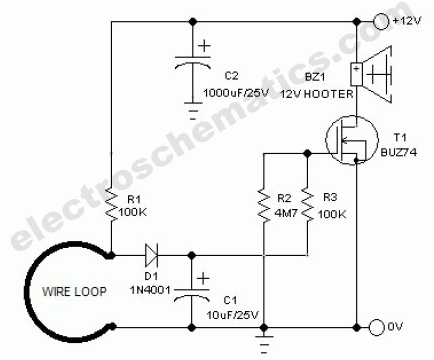
ultrasonic switch circuit
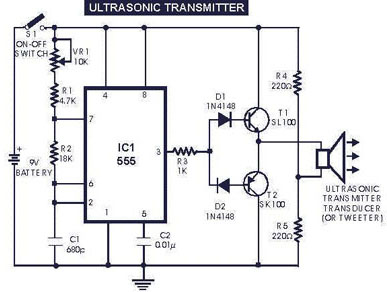
The circuit generates and transmits ultrasonic sound at frequencies between 40 and 50 kHz. It consists of a mini transmitter and a receiver circuit, where the transmitter produces ultrasonic sound, and the receiver detects this sound to activate a relay. The transmitter employs a 555 timer configured as an astable multivibrator, oscillating at the specified frequency. An ultrasonic transmitter transducer effectively emits the ultrasonic sound, powered by a 9-volt PP3 battery. The receiver circuit utilizes an ultrasonic receiver transducer to detect the ultrasonic signals, along with a two-stage amplifier, a rectifier stage, and an operational amplifier in inverting mode. The output from the op-amp is connected to a relay through a complementary relay driver stage. A 9-volt battery eliminator can also be used for the receiver circuit if necessary. When the switch S1 on the transmitter is activated, it generates ultrasonic sound, which is then captured by the receiver transducer, converting it into electrical signals of the same frequency. These signals are amplified by transistors T3 and T4, followed by rectification and filtering. The resulting DC voltage is applied to the inverting pin of op-amp IC2, while the non-inverting pin is connected to a variable DC voltage through preset VR2, determining the threshold value of the received ultrasonic signal for relay operation. The inverted output of IC2 biases transistor T5, which in turn supplies base bias to transistor T6. When T6 conducts, it activates the relay, which can control electrical or electronic devices. Ultrasonic sounds are highly directional; therefore, during operation, the transmitter's ultrasonic transducer must be directed toward the receiver's transducer for optimal performance. To implement a latch function, a DPDT relay can be used, allowing for load switching. A flip-flop can be integrated between IC2 and the relay for additional control. For an ON-time delay, a 555 timer can be placed at the output of IC2, energizing the relay for a duration determined by the timing components of the 555 monostable multivibrator. It is important to note that ultrasonic waves are naturally emitted by various sources, which may lead to false triggering of the circuit, particularly when a flip-flop is included, and no solution exists for this issue.
The circuit operates by generating ultrasonic sound waves, which are transmitted over a short distance. The 555 timer in astable mode provides a continuous square wave output, driving the ultrasonic transducer to emit sound. The frequency range of 40-50 kHz is chosen as it is above the human hearing threshold, allowing for silent operation while still being detectable by the receiver.
The ultrasonic receiver circuit is designed to be sensitive to the specific frequency emitted by the transmitter. The receiver transducer converts incoming ultrasonic waves into electrical signals, which are then amplified through a two-stage transistor amplifier (T3 and T4). This amplification is crucial for ensuring that the signals are strong enough to be processed by the subsequent rectifier and operational amplifier stages.
The rectifier stage converts the AC signals from the receiver transducer into DC voltage, which is then filtered to smooth out any fluctuations. The filtered voltage is applied to the inverting input of the operational amplifier (IC2). By adjusting the preset resistor (VR2), the sensitivity of the receiver can be fine-tuned, allowing for reliable operation in various environmental conditions.
The relay driver stage is designed to handle the output from the op-amp, providing sufficient current to energize the relay (RL1). This relay can be used to control various loads, such as lights or motors, depending on the application. The use of a DPDT relay allows for versatile switching options, enabling both ON and OFF control of the connected load.
Care should be taken to ensure proper alignment between the transmitter and receiver transducers, as ultrasonic signals are highly directional. Misalignment can lead to reduced sensitivity and potential failure to activate the relay. Additionally, the potential for false triggering due to ambient ultrasonic noise should be considered, especially in environments where other ultrasonic sources are present.The circuit described generates (transmits) ultrasonic sound of frequency between 40 and 50 kHz. As with any other remote control system this cirucit comprises of a mini transmitter and a receiver circuit. Transmitter generates ultrasonic sound and the receiver senses ultrasonic sound from the transmitter and switches on a relay.
The ultrasonic tr ansmitter uses a 555 based astable multivibrator. It oscillates at a frequency of 40-50 kHz. An ultrasonic transmitter transducer is used here to transmit ultrasonic sound very effectively. The transmitter is powered from a 9-volt PP3 single cell. The ultrasonic receiver circuit uses an ultrasonic receiver transducer to sense ultrasonic signals. It also uses a two-stage amplifier, a rectifier stage, and an operational amplifier in inverting mode. Output of op-amp is connected to a relay through a complimentary relay driver stage. A 9-volt battery eliminator can be used for receiver circuit, if required. When switch S1 of transmitter is pressed, it generates ultrasonic sound. The sound is received by ultrasonic receiver transducer. It converts it to electrical variations of the same frequency. These signals are amplified by transistors T3 and T4. The amplified signals are then rectified and filtered. The filtered DC voltage is given to inverting pin of op-amp IC2. The non- inverting pin of IC2 is connected to a variable DC voltage via preset VR2 which determines the threshold value of ultrasonic signal received by receiver for operation of relay RL1.
The inverted output of IC2 is used to bias transistor T5. When transistor T5 conducts, it supplies base bias to transistor T6. When transistor T6 conducts, it actuates the relay. The relay can be used to control any electrical or electronic equipment. 2. Ultrasonic sounds are highly directional. So when you are operating the switch the ultrasonic transmitter transducer of transmitter should be placed towards ultrasonic receiver transducer of receiver circuit for proper functioning. 4. For latch facility use a DPDT relay if you want to switch on and switch off the load. A flip-flop can be inserted between IC2 and relay. If you want only an ON-time delay` use a 555 only at output of IC2. The relay will be energised for the required period determined by the timing components of 555 monostable multivibrator.
5. Ultrasonic waves are emitted by many natural sources. Therefore, sometimes, the circuit might get falsely triggered, espically when a flip-flop is used with the circuit, and there is no remedy for that. 🔗 External reference
The circuit operates by generating ultrasonic sound waves, which are transmitted over a short distance. The 555 timer in astable mode provides a continuous square wave output, driving the ultrasonic transducer to emit sound. The frequency range of 40-50 kHz is chosen as it is above the human hearing threshold, allowing for silent operation while still being detectable by the receiver.
The ultrasonic receiver circuit is designed to be sensitive to the specific frequency emitted by the transmitter. The receiver transducer converts incoming ultrasonic waves into electrical signals, which are then amplified through a two-stage transistor amplifier (T3 and T4). This amplification is crucial for ensuring that the signals are strong enough to be processed by the subsequent rectifier and operational amplifier stages.
The rectifier stage converts the AC signals from the receiver transducer into DC voltage, which is then filtered to smooth out any fluctuations. The filtered voltage is applied to the inverting input of the operational amplifier (IC2). By adjusting the preset resistor (VR2), the sensitivity of the receiver can be fine-tuned, allowing for reliable operation in various environmental conditions.
The relay driver stage is designed to handle the output from the op-amp, providing sufficient current to energize the relay (RL1). This relay can be used to control various loads, such as lights or motors, depending on the application. The use of a DPDT relay allows for versatile switching options, enabling both ON and OFF control of the connected load.
Care should be taken to ensure proper alignment between the transmitter and receiver transducers, as ultrasonic signals are highly directional. Misalignment can lead to reduced sensitivity and potential failure to activate the relay. Additionally, the potential for false triggering due to ambient ultrasonic noise should be considered, especially in environments where other ultrasonic sources are present.The circuit described generates (transmits) ultrasonic sound of frequency between 40 and 50 kHz. As with any other remote control system this cirucit comprises of a mini transmitter and a receiver circuit. Transmitter generates ultrasonic sound and the receiver senses ultrasonic sound from the transmitter and switches on a relay.
The ultrasonic tr ansmitter uses a 555 based astable multivibrator. It oscillates at a frequency of 40-50 kHz. An ultrasonic transmitter transducer is used here to transmit ultrasonic sound very effectively. The transmitter is powered from a 9-volt PP3 single cell. The ultrasonic receiver circuit uses an ultrasonic receiver transducer to sense ultrasonic signals. It also uses a two-stage amplifier, a rectifier stage, and an operational amplifier in inverting mode. Output of op-amp is connected to a relay through a complimentary relay driver stage. A 9-volt battery eliminator can be used for receiver circuit, if required. When switch S1 of transmitter is pressed, it generates ultrasonic sound. The sound is received by ultrasonic receiver transducer. It converts it to electrical variations of the same frequency. These signals are amplified by transistors T3 and T4. The amplified signals are then rectified and filtered. The filtered DC voltage is given to inverting pin of op-amp IC2. The non- inverting pin of IC2 is connected to a variable DC voltage via preset VR2 which determines the threshold value of ultrasonic signal received by receiver for operation of relay RL1.
The inverted output of IC2 is used to bias transistor T5. When transistor T5 conducts, it supplies base bias to transistor T6. When transistor T6 conducts, it actuates the relay. The relay can be used to control any electrical or electronic equipment. 2. Ultrasonic sounds are highly directional. So when you are operating the switch the ultrasonic transmitter transducer of transmitter should be placed towards ultrasonic receiver transducer of receiver circuit for proper functioning. 4. For latch facility use a DPDT relay if you want to switch on and switch off the load. A flip-flop can be inserted between IC2 and relay. If you want only an ON-time delay` use a 555 only at output of IC2. The relay will be energised for the required period determined by the timing components of 555 monostable multivibrator.
5. Ultrasonic waves are emitted by many natural sources. Therefore, sometimes, the circuit might get falsely triggered, espically when a flip-flop is used with the circuit, and there is no remedy for that. 🔗 External reference
